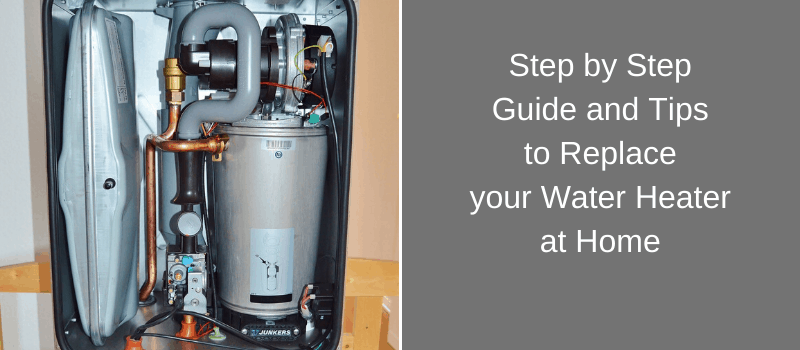It’s a cold day; you went in for a hot shower. But the hot shower does not feel “hotter” the way you want. We understand how frustrating this can be. You may fix certain issues such as insufficient hot water supply or a leak, but have in mind that the water heater may need to be replaced as well.

When to Replace Water Heater?
Water heaters have an average life span of 10-15 years (here is how to find out its age). If you bought your water heater in 2004, your home needs a new water heating unit. Another indication for replacing your water heater is the dripping of water at the tank’s bottom.
Also, if your water heater’s tank is rusty, the damage cannot be controlled. This calls for replacing your water heater as soon as possible. You may call a plumber to help identify the problem and tell if your water heater needs replacement.
Tools to Replace Water Heater
Before you test your plumbing skills, make sure to have all the tools and materials for replacing your old water heater. What type of tools you need may depend on the type of heater you have. However, the general tools for removing and replacing water heaters include
-
Screwdrivers
-
Pipe wrench
-
Wirecutter
-
Electrical tape
-
Tape measure
-
Safety glasses
How to Replace a Water Heater?
There are mainly two stages of replacing a water heater, (1) Removing the old tank, and (2) installing the new water heater.
Removal of the Old Water Heater
-
-
Examine the Type of your Water Heater
-
The first step is to examine the type of heater that needs to be replaced.
-
What is the fuel type of your water heater? Is it an electric model, or does it run ion oil or natural gas?
-
What is the size of your tank? Is it a small one with a storage capacity of fewer than 50 gallons or a larger one?
-
It’s best to go for the same fuel type and size of the water tank that you already have.
-
-
Turn off the Utility Supply
-
Make sure to shut off all the water valves connected to your water heater. Now, turn off the gas or electric supply to the Water heater. Turn the gas valve with an adjustable wrench. For an electric heater, remove the fuse from the water heater or turn off the circuit breaker to cut off the power supply.
-
-
Drain your Water Heater Tank
-
Connect a hose to the drain valve of your water heater and open the valve. Your tank is now ready for drainage.
-
-
Cut off the Waterlines
-
After the tank is drained, cut off the hot and cold water lines that may be connected to the heater with flexible hoses or with soldered connections.
-
-
Change the Water Heater
-
Slid away the old heater, but make sure to take someone’s help as it may be heavy because of the sediments. You may even rent an appliance dolly to bring down your old heater.
Installation of the new Water Heater
-
Position the new Heater
Now that you have removed the old heater, you need to position the new one in place. But before that, don’t forget to wipe down the pooled water from the place.
-
Line up the Plumbing Lines
The next step is to adjust the heater so that all the plumbing connections are lined up in the appropriate connections.
-
Connect the shutoff valve
Make sure to connect a shutoff valve to the cold water supply of your heater if it does not have one. Also, ensure that you use the right fittings.
-
Connect the fuel sources
Depending on the type of your water heater, connect the fuel sources. For a gas water heater, connect the line to the gas burner. For the electrical heater, connect the wires in the electrical junction box.
-
Install the Fittings
After that, you will need to install the water fittings that come along with the water heater. These fittings usually include the TPR valve, discharge drain pipe, and a temperature valve.
Now that you have followed all the steps, you must not forget to turn on the thermostat and wait for the water to get hotter.
Replacing a water heater can be an intimidating and complicated task, especially if you are not much familiar with mechanics. Therefore, it is better to hire a professional contractor via contractor finder websites that you can find easily online.
Related Posts
- 15 Stores Like Home Depot for Your Home Projects (Great Alternatives)
- Types of Portable Toolboxes To Consider Buying for your DIY Projects
- 30 DIY Ugly Sweater Ideas for Christmas and Parties
- 7 Steps To An Affordable DIY Above-Ground Pool
- How Much Weight Can Drywall Hold? Let’s Find Out Here
- How to Install Brick Molding Around Windows and Doors (DIY)
Leave a Reply